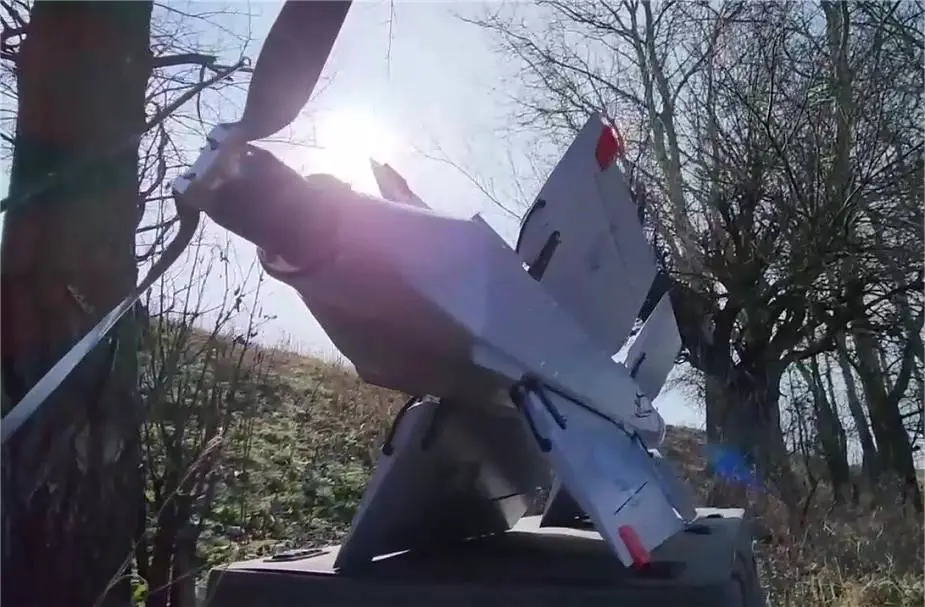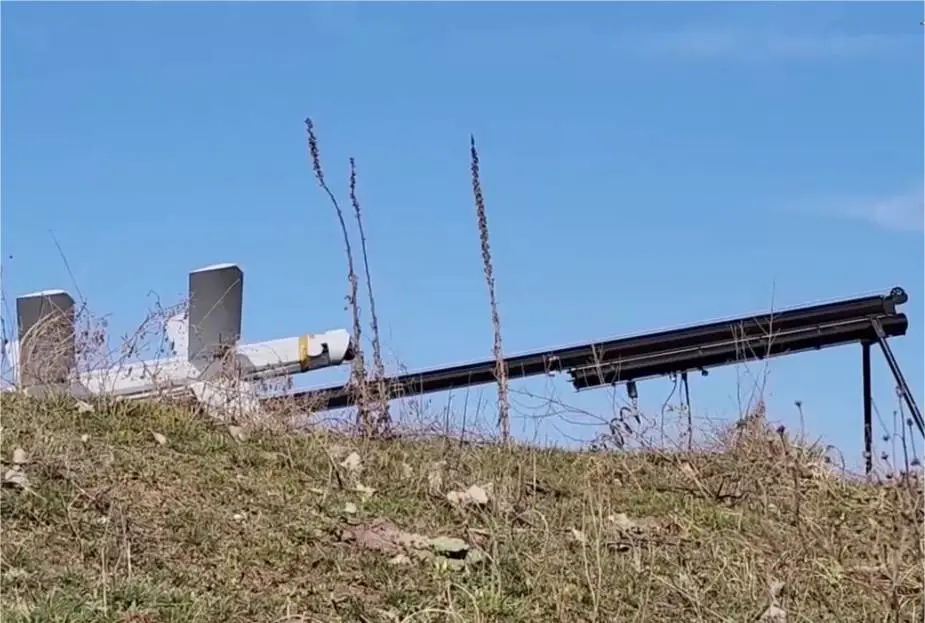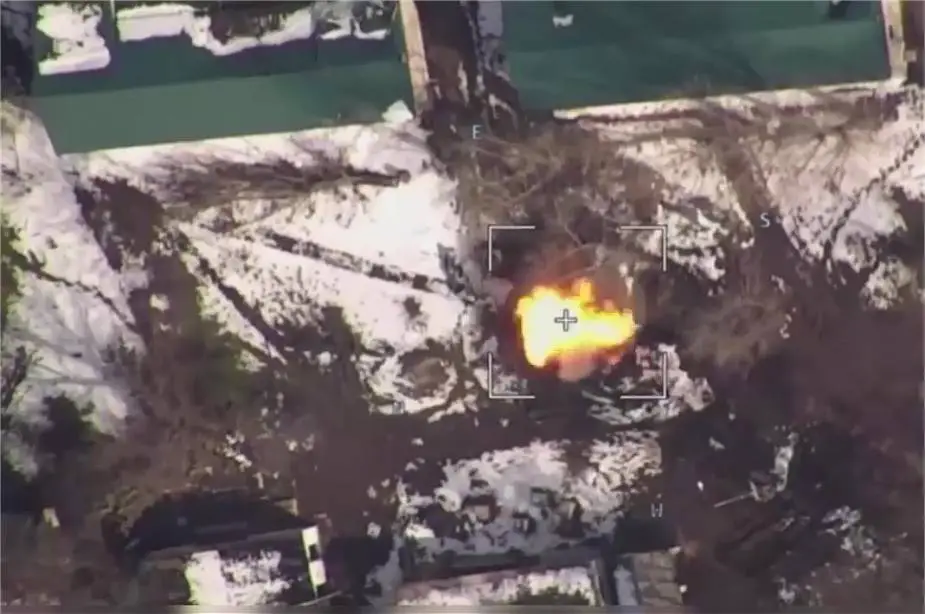On April 6, 2023, the Russian Ministry of Defense released a video showing how the Lancet-3 loitering munition is operated and used for combat operations in Ukraine. Lancet-3 is used in Ukraine since the beginning of the conflict and has transformed from a weapon for localized strikes to a tool for disrupting enemy advances.
Follow Army Recognition on Google News at this link

The Lancet-3 loitering has a unique design called "Double X" allowing the drone to dive at very high speeds while carrying a heavy payload. (Picture source Russian MoD Video Footage)
The Russian army has been using Lancet loitering munitions to destroy enemy infantry and equipment since the start of the invasion of Ukraine. During the summer, the drones were used significantly more frequently, and by autumn, the combat activity of the Lancet loitering munitions had reached its peak. On October 20th, 2022, a video surfaced online showing Lancet-3 drones striking the Msta-B howitzer, radar systems, tanks, and vehicles of the Ukrainian Armed Forces. Previously, it was reported that the Lancet-3 had destroyed a Ukrainian S-300 air defense complex in the Zaporizhzhia direction. On November 6th, 2022, it was announced that the 22nd confirmed hit was made on the M777 howitzer.
The Lancet-3 was developed by the Russian company ZALA Aero. It is designed to destroy ground and air targets and can also perform reconnaissance functions or work in tandem with a reconnaissance drone. It is sometimes compared to other loitering munitions, the American Switchblade-600, but the latter does not have the function of destroying drones, let alone other advantages of the domestic drone.
The wingspan of the Lancet-3 is 1.65 meters, and the glider is made of plastic and carbon fiber. The altitude of the kamikaze drone is 5 kilometers, and the flight time, compared to the first version of Lancet-1, has been increased to 40-60 minutes. The target strike radius is 40 kilometers. The takeoff weight is 12 kilograms, and the combat payload is 3 kilograms. The flight speed is 110 kilometers per hour, and the power unit uses an electric motor, more powerful than the first Lancet-1 and with an increased battery capacity. The Lancet-3 is equipped with anti-laser protection, which helps protect it from modern laser weapons.
Meanwhile, the Lancet-3 is equipped with a thermal imager, video cameras, a gas analyzer, a warning system, a laser target designator, and a dosimeter. Control and flight correction are carried out through a television channel, and targeting is optoelectronic. The Lancet is launched from a catapult, while the American Switchblade 600 drones, used by the Ukrainian Armed Forces, require a special transport-launch container (TLC), making their use in intense combat conditions more difficult.
According to military experts, the main feature of the Lancet-3 is its ability to maneuver, which provides surgical precision for strikes, justifying the drone's name, named after a sharp surgical instrument. The maneuverability of the Lancet is due to an unusual aerodynamic configuration called the "Double X" which is not found in most modern kamikaze drones. In essence, it is a longitudinal biplane with two X-shaped planes. This allows the drone to dive at very high speeds while carrying a heavy payload.

The Lancet-3 loitering munition is launched via a catapult launcher from the ground. (Picture source Russian MoD video footage)
The Lancet-3 is equipped with improved optics, and the presence of a thermal imager allows the drone to operate both day and night. The Lancet-3 does not require satellite navigation and is capable of independently conducting reconnaissance and attacking targets.
Thanks to an increased warhead compared to the previous version, the Lancet-3 has become more lethal. They are also capable of staying in a designated area for some time, searching for targets, and then destroying them. Technically, it looks like this: the drone reaches the designated area and can hover in the air for another 15-20 minutes in search of a suitable target. This simplifies reconnaissance and striking.
The electric motor of the Lancet-3 operates much quieter than a drone with an internal combustion engine, and often the enemy does not even notice it until it is close enough. Thanks to the electric motor, the drone emits very little heat and is almost undetectable for the self-guided warheads of enemy air defense systems.
The Lancet-3 is more convenient to use than self-propelled howitzers, achieving the same or even greater results. According to some reports, in Ukraine, Russian forces may employ up to one and a half thousand Lancet-3 drones in various modifications, allowing them to strike any targets—from the Buk air defense missile system launchers to ammunition depots for American M777 guns and Polish AHS Krab 155mm self-propelled howitzers.
Ukrainians have so far been unable to copy the Russian tactic of using Lancet loitering munitions. In late October 2022, the Ukrainian Armed Forces urgently requested another 1,100 kamikaze drones, Phoenix Ghosts, from the United States, even though Washington had previously provided Kyiv with 700 such drones. According to some reports, the Ukrainian Armed Forces mostly used the Phoenix Ghosts for reconnaissance purposes, rather than striking Russian positions. Most likely, this is related to the operation of the Krasukha electronic warfare system, which suppresses control channels for reconnaissance UAVs and civilian drones.
Currently, the Ukrainian army has also failed to find countermeasures against the Lancet loitering munitions due to their silence and lack of a thermal trail making visual and radar detection impossible, allowing them to strike targets where the enemy least expects it.

Since the beginning of the war in Ukraine, the Lancet-3 has been widely used to destroy Ukrainian combat vehicles and artillery systems.
Defense News April 2023
















